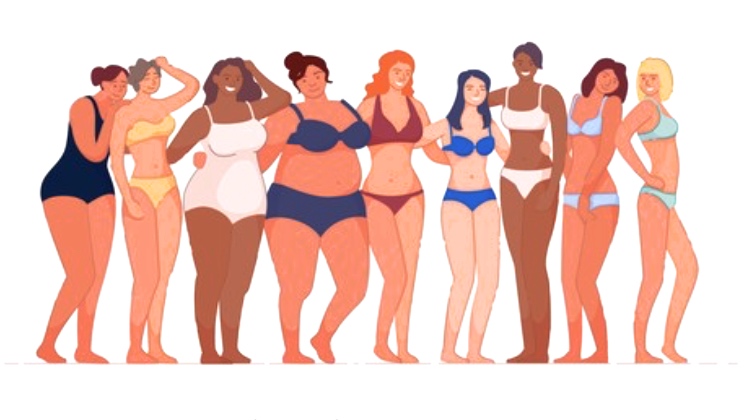
Eating disorders involve food and body image. Food and body image are strongly influenced by the culture we belong to. This blog highlights some of the ways eating disorders present in different communities.
What is an eating disorder?
There are a few different kinds of eating disorders. Three of these disorders involve the strong influence of eating, weight, and body image on a person’s experience of themselves and feelings of distress:
- Anorexia Nervosa – restriction of eating or use of compensatory behaviors (i.e. over-exercise, purging behaviors) to control weight. This leads to a low weight, which a person tries to maintain in spite of negative consequences.
- Bulimia Nervosa – regular episodes of eating where a person feels “out of control”, and consumes large quantities of food in one sitting, then uses a compensatory behavior (i.e. purging) to try to counter the binge and control weight.
- Binge Eating Disorder – regular episodes of binging, without an accompanying compensatory behavior. Like Anorexia Nervosa and Bulimia Nervosa, episodes of eating and concerns about weight are often accompanied by feelings of shame.
What does culture have to do with it?
The community we belong to influences how we feel about:
- What we are “supposed” to look like
- What we weigh
- How we eat
Messages about the “ideal” come from the culture we belong to. This can get tricky when we belong to multiple communities, or belong to a community that has different ideals from the larger “mainstream” culture. Lack of representation in social media, advertising, and movies or TV can also influence how we feel when we are not even included in the “ideal”.
Cultural factors that can influence body image, weight, and eating behaviors:
- Differing cultural practices related to food, eating, and its place in the family, as well as differing body image ideals, which can be tied to race, ethnicity, and country of origin
- Gender identity and messages related to masculinity and femininity
- Sexual identity communities, and experiences of objectification
- Sports and athletic communities and emphasis on weight and performance
It is also important to consider the intersection of these identities. Many people belong to more than one community, which can lead to conflicting messages about weight and body image.
Racial and Ethnic Communities
Historically, research and media has created an image that eating disorders occur mainly in young, White, cisgender women. This is not true!
- Members of BIPOC (Black, Indigenous, and People of Color) communities are less likely to be identified as having an eating disorder or referred to appropriate services by medical professionals, but are just as likely as Non-Latinx White counterparts to struggle with an eating disorder (Cheng et al, 2011; Lee-Winn et al., 2014; Marques et al., 2011).
- Eating disorders are rising in Hispanic and Latinx women in the U.S. This may be related to acculturative factors, and increasingly globalized media representations of the “thin ideal” (Alegria, 2007; Cheng et al., 2011).
- Communities with a cultural emphasis on plastic surgery, such as Brazil, Colombia, and South Korea, can influence body image and related self-worth (Inter-American Development Bank, 2006; Park et al., 2019; Sarwer & Polonsky, 2016; Twigg, 2017).
- Many cultures express emotions physically. It can be normal to experience emotions as gastrointestinal or somatic symptoms. This can impact the use of the body as a means of regulating or experiencing emotions, which can play a role in eating disordered behaviors. (Choi et al., 2016; Kirmayer & Young, 1998)
LGBT+ Communities
Eating disordered behavior looks vastly different within each of the LGBT+ communities and subcultures. Differing experiences of the body, gender and identity, and levels of objectification can all play a role.
- For transgender individuals, eating disordered behavior can serve a utilitarian purpose, where losing or gaining weight is intended to create a physical body more in line with identity (Jones et al, 2016).
- Subcultures of the gay male community experience high rates of objectification. This can contribute to higher rates of eating disordered behavior and body dissatisfaction (Wiseman & Moradi, 2010).
- Conversely, members of the lesbian community may experience lower rates of eating disordered behavior, however research is conflicting on this topic; some research suggests that lesbian women are at higher risk of experiencing an eating disorder than heterosexual or gay or bisexual identified individuals (Mason et al, 2018; Parker & Harriger, 2020).
- Members of the LGBT+ community are at higher risk of trauma, discrimination, and adverse experiences (such as homelessness), which can increase risk of mental health concerns. Higher body awareness can be protective for LGBT+ individuals who have experienced harassment and discrimination based on identity and gender expression, but this body monitoring can also increase risk for an eating disorder (Parker & Harriger, 2020; Wiseman & Moradi, 2010).
Minority Stress and Representation
Stress impacts wellbeing. Members of marginalized, minority, and BIPOC communities are more likely to experience stressors related to social and systemic inequities, prejudice, and barriers to receiving needed care and support, which can in turn impact mental health.
- Stressors related to belonging to a marginalized or minority community, and acculturative stress, can influence overall functioning, and related coping and self-worth, including eating and body image. (APA, 2012; Calzo et al., 2017)
- Social media, advertising, and media such as movies and television does not typically represent the full diversity of the U.S. For the transgender youth or the Black girl who is fed a message of an “ideal” that does not look like them, there can be a serious and lasting impact. (Martins & Harrison, 2012; Ramasubramanian & Saleem, 2017; Zhang & Haller, 2016)
- These messages can influence efforts to change the body, or regulate difficult emotions through eating disordered behaviors. While representation on a larger scale is crucial, on a smaller scale building empowerment and addressing contingencies of self-worth in the individual is also vital.
Conclusion
Culture and identity are crucial components of eating and body image concerns. While I have neatly squeezed different cultural communities into discrete boxes for the purposes of this post, it is important to emphasize the intersectionality that occurs across these different communities. Furthermore, this is by no means a full representation of the different identities and communities that individuals belong to. It is necessary that a person’s lived experience be considered in the identification and treatment of eating disordered behavior.
At Anxiety Specialists of Atlanta we recognize that struggles with eating disordered behavior and body image are not “one size fits all”, and we work to consider the needs of the individual in our approach to treatment. We welcome individuals of all backgrounds and walks of life to seek treatment for their struggles, and we take into account the lived experience of each person who needs our help. If you’re wondering if we’re the right fit for you, don’t hesitate to reach out. You deserve to receive the right care and support for your needs.
Dr. Megan Faye
Licensed Psychologist
Clinical Associate, Anxiety Specialists of Atlanta
Dr. Faye specializes in the assessment and treatment of anxiety, OCD, and disordered eating for children, adolescents, and adults
**Stay tuned for future posts exploring eating disordered behavior in Men and Athletes!
Resources and Articles for Further Reading:
- https://www.nationaleatingdisorders.org/identity-eating-disorders
- https://www.lgbtqiahealtheducation.org/wp-content/uploads/2018/04/EatingDisordersBodyImageBrief.pdf
- https://slate.com/human-interest/2014/03/eating-disorders-and-women-of-color-anorexia-and-bulimia-are-not-just-white-girl-diseases.html
- https://www.latinousa.org/2014/03/21/eating-disorders-latins-risk/
- https://www.verywellmind.com/race-racism-and-eating-disorders-5076344
- https://www.emilyprogram.com/blog/beyond-eating-disorders-dont-discriminate/
Face your fears. Live with uncertainty. Take control of your life.

